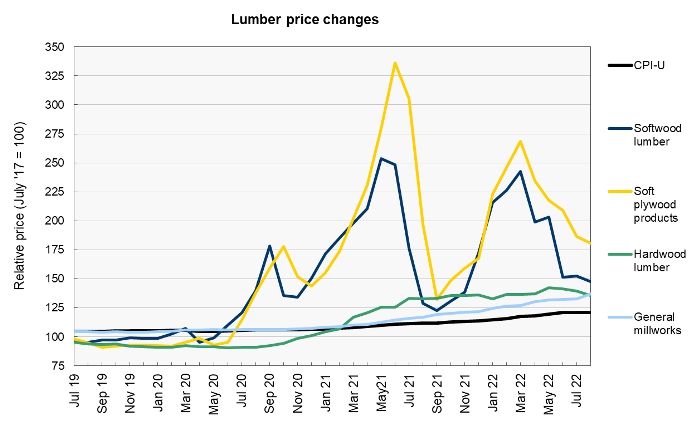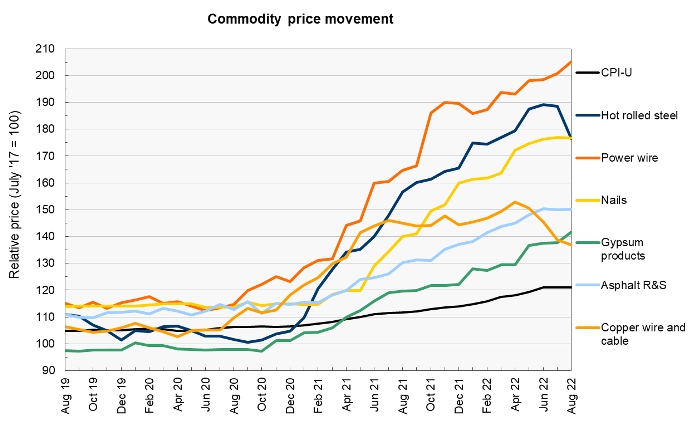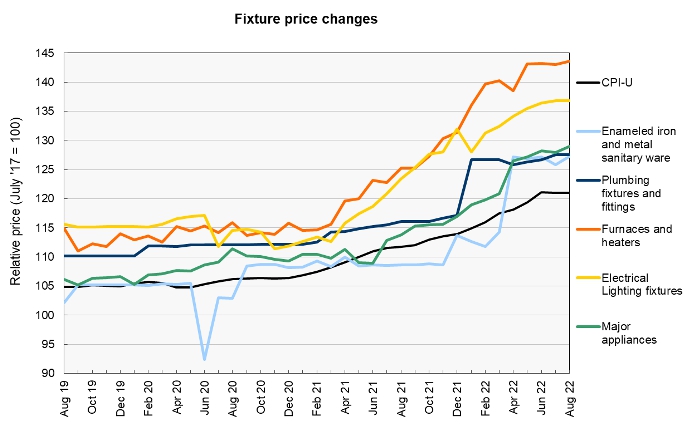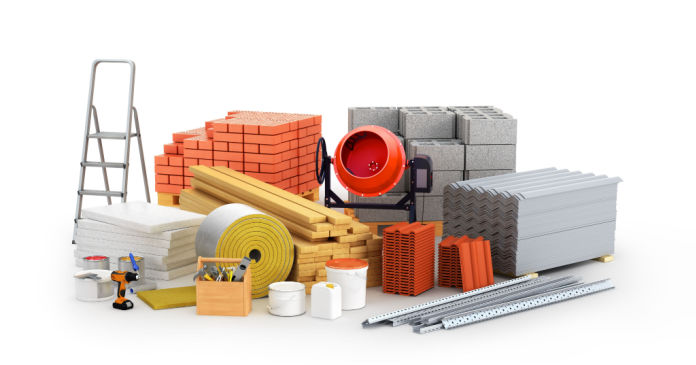The August producer price index (PPI) report from the Bureau of Labor Statistics (BLS) stated that construction materials prices were up 0.4 percent in the month, seasonally adjusted. The index was 15.2 percent higher than its year-earlier level. Both rates are higher than those reported last month.
Overall prices for processed goods for intermediate demand fell by 1.7 percent in the month driven by a 5.2 percent drop in the prices for energy products. The processed goods for intermediate demand index was 14.1 percent higher than its year-ago level.
For reference, the changes in these indices compare with an 8.3 percent rise in the all-items consumer price index (CPI-U) for the 12 months ending in August. The seasonally adjusted August CPI-U was up 0.1 percent from July’s level. The shelter portion of the CPI was up 0.7 percent for the month and was 6.2 percent higher than its year-ago level.
Yield Pro compiled the BLS reported changes for our standard list of construction materials prices. These are prices of materials which directly impact the cost of constructing an apartment building. The two right hand columns of the table provide the percent change in the price of the commodity from a year earlier (12 Mo PC Change) and the percent change in price from July 2022 (1 Mo PC Change). If no price data is available for a given commodity, the change is listed as N/A.
The pre-COVID column lists the changes in the current construction materials prices relative to the average of prices from December 2019 through February 2020, before the pandemic impacted the economy. This may give a truer idea of the magnitude of the recent price increases for materials, such as lumber, whose prices were already rising sharply last year, than does the 12 Mo PC Change column.
| Commodity | 12 Mo PC Change | 1 Mo PC Change | Pre-covid Change |
| Softwood lumber | 14.8 | -3.1 | 47.6 |
| Hardwood lumber | 2.0 | -2.8 | 48.7 |
| General millworks | 17.1 | 3.2 | 31.1 |
| Soft plywood products | -8.2 | -3.0 | 95.5 |
| Hot rolled steel bars, plates and structural shapes | 12.7 | -6.4 | 70.3 |
| Copper wire and cable | -5.6 | -1.3 | 28.6 |
| Power wire and cable | 24.7 | 2.2 | 76.4 |
| Builder’s hardware | 14.2 | 2.3 | 26.8 |
| Plumbing fixtures and fittings | 9.9 | 0.1 | 15.2 |
| Enameled iron and metal sanitary ware | 17.2 | 1.1 | 21.1 |
| Furnaces and heaters | 14.6 | 0.4 | 26.5 |
| Sheet metal products | 17.3 | 1.1 | 48.6 |
| Electrical Lighting fixtures | 10.8 | 0.0 | 18.8 |
| Nails | 26.2 | -0.1 | 54.7 |
| Major appliances | 13.4 | 0.8 | 21.4 |
| Flat glass | 17.2 | 3.5 | 30.2 |
| Ready mix concrete | 11.0 | 1.6 | 19.3 |
| Asphalt roofing and siding | 15.2 | 0.2 | 34.4 |
| Gypsum products | 18.4 | 2.8 | 42.9 |
| Mineral wool insulation | 14.8 | -6.2 | 39.9 |
The first chart, below, shows the price index history for wood products over the past 37 months. Note that the prices used by the BLS in compiling the indexes are collected on the Tuesday of the week containing the 13th day of the month. In August 2022 that would have been August 9.

The prices of wood products generally moved lower this month with the price of softwood lumber falling for the month despite its prices for the two prior months being revised lower. The prices of plywood and hardwood lumber also fell for the month, although the price of general millworks edged higher. Comparisons to year-earlier prices have to be viewed in light of those prices being at or near low points.
Markets Insider reported that the market price of lumber has recently been close to its mid-August level. It closed on September 13 at $560, up $7 since August 9. This suggests that the price of lumber may rise, but only slightly, in next month’s PPI report. Lumber prices in the futures markets have fallen since last month, despite moving higher in recent days. The November 2022 futures contract closed at $547 on September 13, down $35 since our last report. The January 2023 contract closed at $540, down $96 since our last report.
The next chart, below, shows the recent history of several other construction materials prices. These are relatively simple commodities whose prices are strongly driven by those of the materials of which they are comprised. The prices for many of these commodities are now up more than softwood lumber relative to their pre-pandemic levels. However, their price rises have been more of a steady march than the wild swings seen in lumber prices.

The biggest price move this month among these commodities was for hot rolled steel bars, whose price fell 6.4 percent on top of a -0.8 percent revision of its price in July. The price of copper wire also trended lower, although partly because the previous month’s price was revised 1.2 percent higher. However, most of the other construction materials prices illustrated by this chart continued their recent steady rise.
MarketWatch reports that the NYSE American steel index was steady for much of the month of August but has moved lower in September. It closed on September 13 at $1,532, down $99 from its level of a month ago. Steel futures have also moved lower since mid-August. The November 2022 contract closed on September 13 down 8 percent from its level on August 9. The January 2023 contract is also down 8 percent over the past month.
The price of copper has been relatively steady since we last reported on it. It closed at $3.59 per pound on August 9, while it closed at $3.56 per pound on September 13.
The price of aluminum traded in a relatively narrow range since late June but has shown weakness in September. It closed on September 13 at $2,313, down $177 since our last report.
Price changes for several of the more finished goods from our sample are illustrated in the final chart, below. They generally continued their steady move higher.

The full BLS report can be found here.













